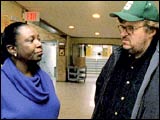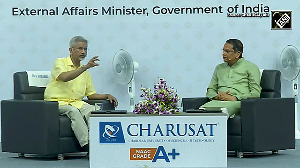Imagine a documentary that cost about $75,000 grossing $5 million -- and more to come from international runs and DVD and video sales.
We are talking about Spellbound.
Imagine a $3 million documentary Bowling at Columbine not only getting a standing ovation at Cannes and various other film festivals, but going on to earn $100 million worldwide in movie theatres and video stores.
 No surprise then that some of the hottest films buyers are after at festivals are documentaries.
No surprise then that some of the hottest films buyers are after at festivals are documentaries.
The 41st edition of the New York Film Festival is showing several documentaries that are bound to draw wide attention.
The Fog of War: The festival centrepiece is a 95 minute film by acclaimed director Errol Morris that focuses on the conscience of Robert S McNamara, one of the most controversial names in American politics.
A WW II military strategist, auto executive (president of Ford Motor Company) and, most controversially, defence secretary in the Kennedy and Johnson administrations during the escalation of the Vietnam war, he ponders Morris's question: How can a mere mortal come to terms with history, particularly when he has done so much to shape it?
| |||||||||||
Morris, the maker of such award-winning documentaries as A Brief History of Time and The Thin Blue Line, lets McNamara, nearly 87 but sharp as ever, lead the way. The filmmaker smartly uses archival footage, visual aids, and a Philip Glass score to offer an ironic counterpoint.
'What develops is a haunting, crystal-clear portrait of human error in action,' notes the NYFF selection committee brief. 'A genuine tour-de-force from a filmmaker at the top of his form.'
One of the hottest films at the Toronto International Film Festival, the chilling documentary reminded some critics that the film allows viewers to draw their own parallels to the war in Iraq.
Morris says he was inspired to make the film after he read McNamara's 1995 memoirs in which he thinks of the moral dimensions of his action. In talking with McNamara, Morris not only questions him about his Vietnam war policies but also in firebombing Japanese cities during WW II.
Sony Pictures Classics will soon release the film.
Stalingrad: The city with the name Stalingrad may no longer exist, but it has been immortalised as the scene for the fiercest and unquestionably most decisive battle of World War II.
The epic and gruelling confrontation between Nazi German and Communist Russian armies -- which left almost one million dead -- at Stalingrad in 1942-43 not only decided the outcome of World War II, but possibly the shape of the last century.
Using period footage, including some 8mm films shot by the soldiers themselves, as well as interviews with survivors from both sides -- ranging from ordinary conscripts to officers close to the military authorities -- film-maker Sebestian Dehnhardt takes a 156 minute-long, in-depth look at the events leading up to the attack, the battle itself, and its aftermath.
S21, The Khmer Rouge Killing Machine: In the mid-1970s, Cambodia's genocidal communists, the Khmer Rouge, converted the Tuol Sleng High School in Phnom Penh into the S21 detention centre.
Between 1975 and 1977, of the roughly 17,000 people who passed through its doors, only seven survived.
Filmmaker Rithy Panh, who himself spent four years in a Khmer Rouge labour camp before escaping to Thailand and then to France, accompanies the detention centre's official painter, Vann Nath, on his first visit to S21 in more than 20 years.
He also confronts several of his former captors and tormentors. He interviews two of the survivors in the camp itself.
Panh asks the guards to re-enact their former routines; he gets the names and details of the victims. More importantly, he captures their stories.
The most horrifying discovery of the film is that torturers and victims felt the terror of the Khmer Rouge alike. For about four years, thousands were held in the grip of an ideological terror that could have shamed even Stalin and Hitler. At least two million people died across the little country.
Panh's ultimate goal is to explore the possibility of reconciliation between victims and victimisers. "My way of carrying out my share of remembrance is by talking and providing a platform for the witnesses of the genocide," Panh has said, "both victims and torturers. I would like to think that each testimony is one small stone that helps to build up a rampart against a threat that is always possible, here and elsewhere: the return of barbarism."






 © 2025
© 2025